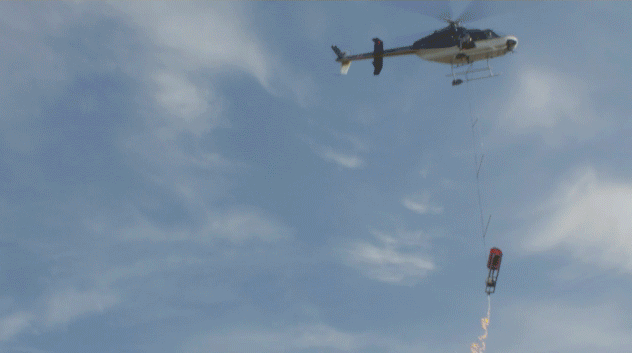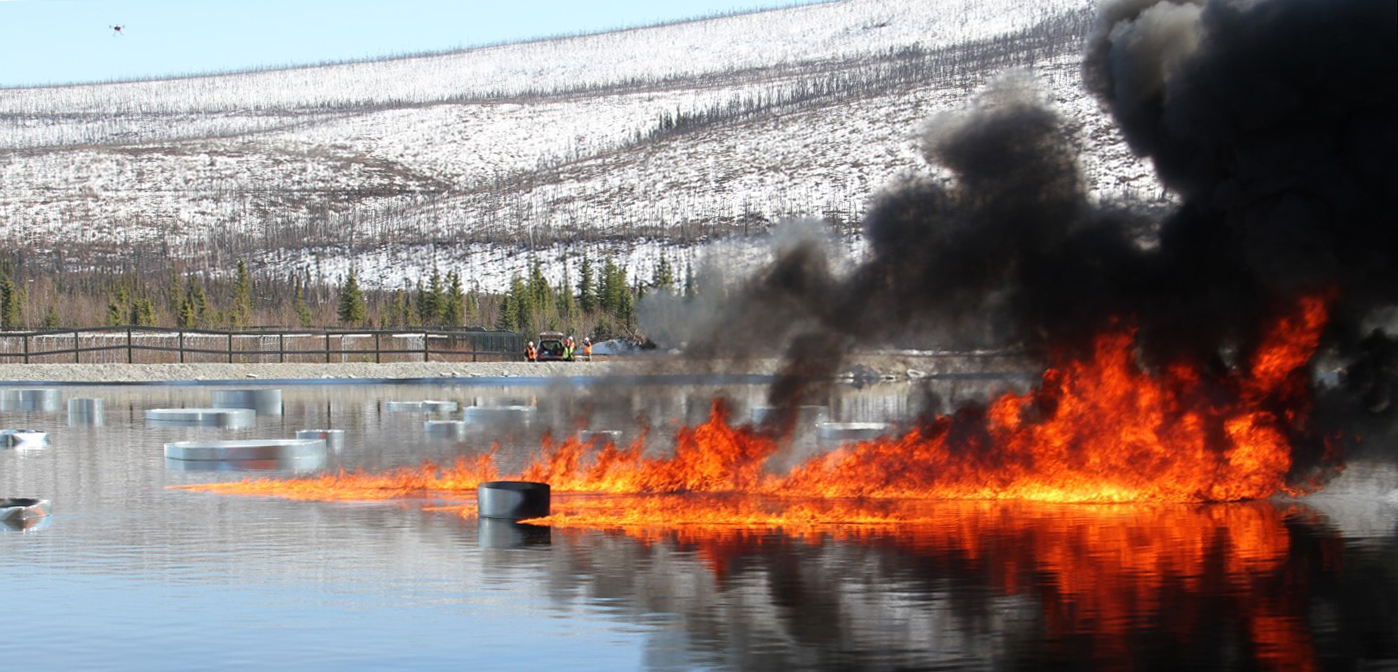Drones Offer Hope for Fighting Arctic Oil Spills
Ships are flocking to the Arctic, increasing the risk of a spill in an ill-prepared region.
Article body copy
Jessica Garron’s eyes light up when she talks about the fire.
It was less than a year ago when Garron, a researcher at the University of Alaska, watched a drone hoist a drum of gelled gasoline, outfitted with an igniter, over a mock oil spill in a 90-by-90-meter pool north of Fairbanks. The contraption dropped blobs of fire from the sky onto the oil slick, igniting it and sending a plume of black smoke into the air.
Despite the over-the-top theatrics, Garron warns that the research bears a realistic—and ominous—message: we’re not ready for an oil spill in the Arctic.

A helicopter drops flaming gelled gasoline onto a simulated oil spill. In other trials, the researchers used a small drone in place of the helicopter. Video by Geophysical Institute Design Services of the University of Alaska Fairbanks
The Arctic is changing quickly. Temperatures in the North are increasing faster than in the rest of the world, and the previously reliable seasonal sea ice is forming later and breaking up earlier. Less sea ice creates more opportunities for shipping. More shipping brings more oil and a rising threat of an oil spill in a region that is ill-prepared to cope.
The disappearing sea ice is also creating new challenges for disaster response. “We can’t get on the ice anymore,” Garron says. “How can we get to a spill?”
Partially melted sea ice is ill-suited to be used as an operating platform for an oil spill cleanup, but a traditional ship-based cleanup operation is risky, with icebergs and rafting ice still posing a threat to vessels, as well as extreme weather conditions. “I think [unmanned aerial vehicles] are going to play a significant role in future oil spill response,” Garron says.

According to the US coast guard, the number of ships passing through the Bering Strait grew from 130 in 2009 to nearly 500 by last year. Photo by Janet Foster/Masterfile/Corbis
With the conditions in the Arctic changing so rapidly, and the number of ships passing through climbing swiftly, the team is in a rush to figure out the best way to fight an oil spill in the Arctic.
“One of the issues with doing research on Arctic marine spills is that one can’t spill a bunch of the oil into the ocean and practice cleaning it up,” Garron says, adding that using drones to track spills “is brand new stuff that wasn’t in anybody’s contingency plans.”
So, in late 2014, Garron and a team of researchers set out to create a test facility where they could practice.
In September of that year, they dug a pool—complete with moose barriers—and harnessed a small team of undergrads (who “didn’t know what they were getting into,” Garron quips) to grow icebergs in kiddie pools in -34 ˚C weather.
Every step of the way, Garron says, there were unexpected challenges: kiddie pools shatter in -34 ˚C temperatures, for instance.
The experiments, which took place in the spring of 2015, saw the team practice cleaning up oil spills in their simulated sea.

Two of the drone vehicles used by the researchers in their trials. Photo by Geophysical Institute Design Services of the University of Alaska Fairbanks
After they released the oil into the pool, the team used a helicopter to drop chemical herders around the oil, pushing it into one area. Then they used their drone to firebomb the slick, burning it off. Garron says the tests were a success.
There’s a perfect storm forming for the occurrence of a catastrophic oil spill in the Arctic, Garron warns. Not only is there a gap in knowledge, but there is little training or response infrastructure in Alaska’s coastal villages—the very places that would be hardest hit by an oil spill, as many indigenous communities continue to rely on traditional fishing and hunting to survive.
Garron estimates there will likely be a significant spill in the Arctic within the next 10 years. Spill management research, however, has largely been put on hold. Much of the funding for this research comes from oil and gas companies, and as oil prices have plummeted, that funding has dried up—even as shipping continues to increase.
“It’s horrifying. There are so many possibilities for disaster there,” Garron says.

